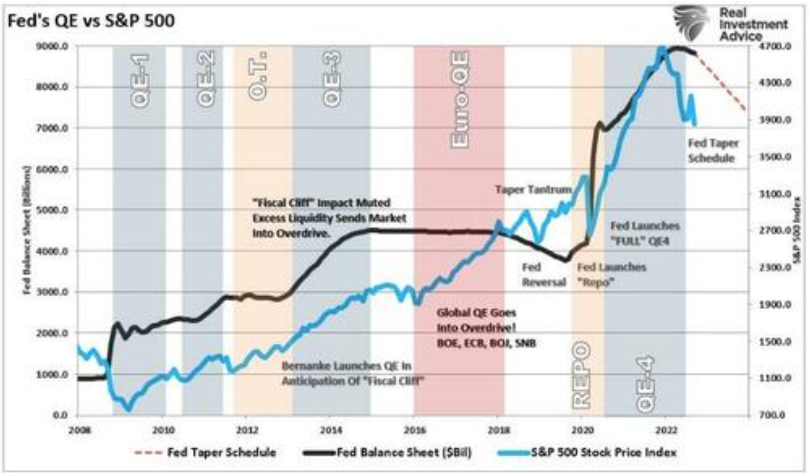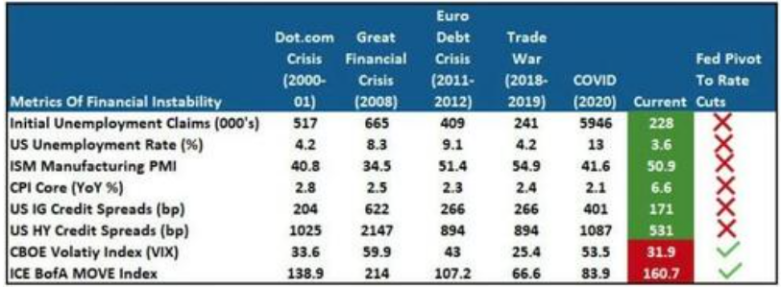The next financial crisis has already started again from the US. Unlike 2008, when subprime loans froze market trading and Lehman Brothers went bankrupt, in 2022, it may be the $27 trillion U.S. Treasury bond market that brings worldwide collapse. When historians of the future look back on 2022, they will remember it as a year when nothing ever worked.
Throughout its duration, interest rates, Russia’s invasion of Ukraine, increased energy costs, inflation, which has climbed to the highest levels in 40 years, and liquidity outflows from stocks and bonds have squeezed markets violently. Since 1980, bonds have been a defacto hedge. However, in 2022, they suffered the worst sell-off in 100 years, with the typical 60/40 stock and bond portfolio returning a terrifying -34.4%, as fund managers revealed.
The fall in bonds is the important one. This market is the “life” of the economy. Today, more than ever, the economy requires ever-increasing levels of debt to function: from companies issuing bonds for stock buybacks to consumers increasing leverage to maintain their standard of living. Also, governments require continued debt issuance to finance spending programs, as total tax revenues are insufficient to pay transfer payments, pensions, and debt relief.
The problem occurs when interest rates rise. Higher interest rates reduce the number of willing borrowers, and debt buyers don’t want prices to fall. The last one is the most important. When debt buyers evaporate, the ability to issue debt to finance spending becomes increasingly problematic.
The outstanding debt (bonds) has increased by $7 trillion since 2019. However, at the same time, large financial institutions acting as “major traders” are not willing to act as net buyers. One of the main reasons for this is that for the past decade banks and brokerages have had one primary buyer to whom they could offload the bonds they held: the Federal Reserve. Today, the Federal Reserve no longer acts as a willing buyer. Consequently, traders are also reluctant to buy bonds. Also, liquidity continues to evaporate.
Each rate hike brings the Fed closer to the unwanted “event horizon. But what should worry the Fed and the US Treasury most is the worsening demand in US debt auctions. A key indicator called the supply-to-coverage ratio of the government’s latest ten-year bond issuance, $32 billion, was more than one standard deviation below last year’s average.
Unfortunately, history is littered with monetary policy mistakes, with the Federal Reserve tightening policy too much. As markets rebel against quantitative tightening, the Fed will eventually acquiesce to a deluge of selling. The destruction of “wealth” threatens the functioning of both stock and credit markets. We are already seeing the first cracks in both the foreign exchange and government bond markets. However, volatility is rising to levels that signal systemic episodes, and when the effect of monetary policy lag collides with accelerating economic weakness, the Fed will realize its mistake.
Get Full Access To Our Premium Analysis For 14 Days. Click here!
By using Wavetraders website, any services, products, and content contained here, you agree that use of our service is entirely at your own risk. You understand that there is a very high degree of risk involved in trading on the markets. We assume no responsibility or liability for your trading and investment results. The charts, and all articles published on www.wavetraders.com are provided for informational and educational purposes only!
By using the information and services of www.ew-forecast.com you assume full responsibility for any and all gains and losses, financial, emotional or otherwise, experienced, suffered or incurred by you.
Recommended Content
Editors’ Picks

EUR/USD accelerates losses to 1.0930 on stronger Dollar
The US Dollar's recovery regains extra impulse sending the US Dollar Index to fresh highs and relegating EUR/USD to navigate the area of daily troughs around 1.0930 in the latter part of Friday's session.

GBP/USD plummets to four-week lows near 1.2850
The US Dollar's rebound keep gathering steam and now sends GBP/USD to the area of multi-week lows in the 1.2850 region amid the broad-based pullback in the risk-associated universe.

Gold trades on the back foot, flirts with $3,000
Gold prices are accelerating their daily decline, steadily approaching the critical $3,000 per troy ounce mark as the Greenback's rebound gains extra momentum and US yields tighten their retracement.

Can Maker break $1,450 hurdle as whales launch buying spree?
Maker holds steadily above $1,250 support as a whale scoops $1.21 million worth of MKR. Addresses with a 100k to 1 million MKR balance now account for 24.27% of Maker’s total supply. Maker battles a bear flag pattern as bulls gather for an epic weekend move.

Strategic implications of “Liberation Day”
Liberation Day in the United States came with extremely protectionist and inward-looking tariff policy aimed at just about all U.S. trading partners. In this report, we outline some of the more strategic implications of Liberation Day and developments we will be paying close attention to going forward.

The Best brokers to trade EUR/USD
SPONSORED Discover the top brokers for trading EUR/USD in 2025. Our list features brokers with competitive spreads, fast execution, and powerful platforms. Whether you're a beginner or an expert, find the right partner to navigate the dynamic Forex market.

